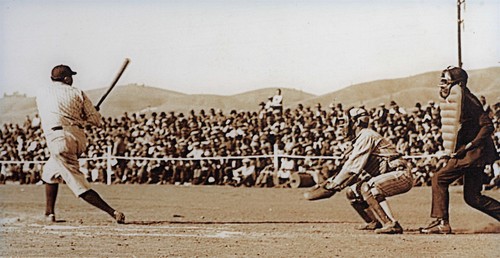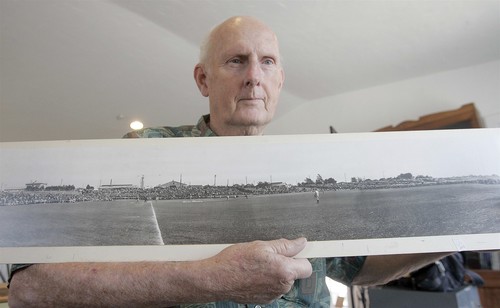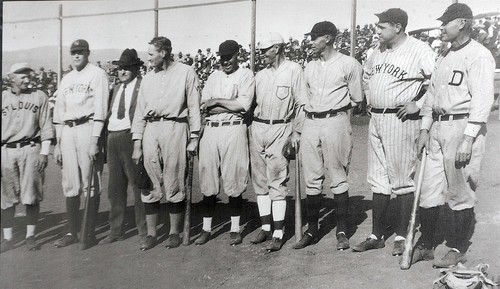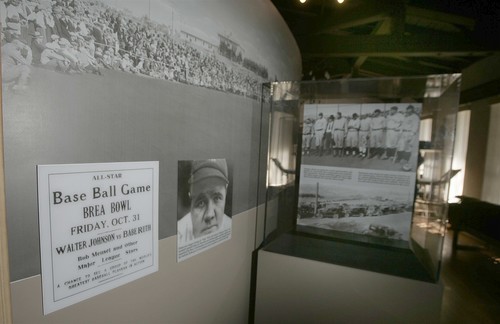The year the Big Train stopped in Brea, and brought the Babe

Babe Ruth bats in an exhibition on Oct. 31, 1924, at the Brea Bowl, a natural amphitheater. The game was part of a postseason barnstorming tour and is commemorated in an exhibit at Brea Museum and Heritage Center. A residential/commercial neighborhood now stands on the bowl site. -- Brea Museum and Heritage Center photo
The Orange County community was a tiny oil town in 1924 when favorite son Walter Johnson and Babe Ruth played an exhibition game there on a postseason barnstorming tour.
By Chris Dufresne, Los Angeles Times Staff Writer
June 2, 2008
Careful examination of an old photograph and a street map determined this had to be the spot -- or at least near the spot.
It's all tract homes now, the memories buried beneath cul-de-sacs just downslope from the intersection of Brea Boulevard and Lambert Road, but something special happened here a long time ago.
Did anyone know?
A man, on a Saturday, was washing his car on St. Crispen Avenue when a reporter approached and posed the question, half expecting a "what-the-?" response.
Barry Ghrist, instead, set aside his wash rags and smiled.
He looked down at his driveway.
"I'm guessing we're standing close to second base, right on the edge of the infield," Ghrist said.
Ghrist knew.

Leon Stevens, a docent at the Brea Museum and Heritage Center, holds a mural of photos taken during a 1924 exhibition at the old Brea Bowl, a natural amphitheater owned by Brea Oil.1 -- Alex Gallardo / Los Angeles Times photo
On Oct. 31, 1924, in Brea, an oil town in north Orange County, on ground now beneath Ghrist's feet, Babe Ruth swatted two home runs against Walter Johnson in a baseball game.
What?
One of Ruth's blasts was estimated to have traveled 550 feet -- one of his longest ever.
Come again?
Not only did Ruth sock two homers, he pitched a complete-game victory.
Seriously?
Johnson, a 23-game winner and the American League most valuable player in 1924, gave up eight runs in five innings and took the loss. Johnson could have blamed arm fatigue, having recently pitched the Washington Senators to the World Series championship.
This is no Hollywood yarn -- Shoeless Joe Jackson walking out of a cornfield.
It honest-to-Honus (Wagner) happened.
Two of the five players in baseball's first Hall of Fame class once laced up cleats where Ghrist was now washing his car.
"Somewhere in my backyard is third base," he said.
Back then his parcel patch was the infield skin of the Brea Bowl, a natural amphitheater owned by Union Oil.1 The 1924 exhibition game, organized by the Anaheim Elks, was part of a postseason barnstorming tour.
No one who attended the game is believed to be still living, so the memories now are secondhand. The physical proof -- Ruth's signature on a baseball, pictures -- is on exhibit at the Brea Museum and Heritage Center.

A baseball signed by Babe Ruth and Walter Johnson is displayed at the Brea Museum and Heritage Center. -- Alex Gallardo / Los Angeles Times photo
Bob Bickel, who turns 81 in June and his lived his entire life in Brea, was born three years after the game.
"There's not too many of us old ones anymore," said Bickel, who worked at Union Oil for 35 years and was also a local mail carrier.
There's not much left of old Brea, either, its once "old-town" main street having been mostly modernized.
Bickel studied a large panoramic photograph of the game, shot from right field looking toward home base, the left-field foul line running parallel to Brea Boulevard.
"This building is still here," Bickel said as he pointed to the structure that today stands as Ron and Wayne's Automotive.
The Babe Ruth/Walter Johnson story was recounted many times in Bickel's youth and remains a part of the city's lore.
How, though, and why?
Many know Walter Johnson as one of the greatest pitchers in baseball history, amassing 417 wins and 110 shutouts in a career that spanned 21 years, all with the Washington Senators (also known as the Nationals). Johnson was the hardest thrower of his era, nicknamed "The Big Train" by sportswriter Grantland Rice, and his strikeout record of 3,509 stood for more than five decades before Nolan Ryan broke it.
Not as many know that, though Johnson was born in Kansas and died in Washington, D.C., he spent formative years in Southern California.
Walter's father, Frank, brought his family west at the turn of the century in search of oil and found it in Olinda, a burgeoning boomtown east of Brea. It was here that Johnson frolicked as a teenager, rode a black mare, worked the rough-and-tumble oil fields, began playing baseball for the Union Oil Wells2 and forged his future.
Johnson attended Fullerton Union High long enough to have, in 1905, struck out 27 batters in a 15-inning game against Santa Ana High.
No oil town could hold this kind of talent, though, and two years later Johnson was pitching for big league paychecks.
Johnson was 36 and nearing the end of a great career when he triumphantly returned to Brea in 1924 only days after winning Game 7 of the World Series against the New York Giants. It was the only championship ever won by the mostly sad-sack Senators and a crowning, about-time moment for the beloved Johnson. Think, in modern terms, of John Elway finally winning a Super Bowl.
Johnson's Orange County friends crowded around newspaper offices to get updates from the 1924 World Series. Some, according to his biographer, crowded around primitive radio "crystal sets."
Johnson returned west for a little business and barnstorming and brought with him a pretty good ringer . . . Babe Ruth.
The Yankees failed to win the pennant in 1924, but it wasn't Ruth's fault. He won his only batting crown that year, hitting .378, led the league with 46 home runs and drove in 121 runs.
The Anaheim Elks even coerced Ruth into riding with Johnson in a pregame Halloween parade.
An Anaheim Bulletin headline -- "All roads lead to Brea for Monster Athletic Contest" -- summed up the pregame sentiment.
The Los Angeles Times dubbed it "the greatest de luxe sandlot game Southern California has ever seen."
Two thousand seats were erected at the Brea Bowl to accommodate the fans. Some estimated a crowd of 15,000 had descended on a town of 1,500 citizens.

Some estimates put attendance of an exhibition game at Brea Bowl at 15,000, 10 times the population of Brea in 1924. Walter Johnson, who had ties to nearby Olinda, pitched for one team; Babe Ruth pitched, and homered twice, for the other. Ruth's team won, 12-1 or 11-1. -- Brea Museum and Heritage Center photo
School that Friday was canceled. The Boy Scouts directed parking, the American Legion policed the grounds, the local churches supplied refreshments and Babe Ruth provided the punch.

Walter Johnson, left, pitched the Washington Senators to victory in the World Series before facing Babe Ruth, right, in an exhibition game in 1924. -- Alex Gallardo / Los Angeles Times photo
Both squads were sprinkled with local and big league talent. Johnson's squad included a few chums from his Olinda days along with Bob Meusel, Ruth's Yankees teammate. Ruth had on his side future Hall of Famer Sam Crawford, who had retired in 1917.

Future Hall of Famers Babe Ruth, second from right, and Walter Johnson, fourth from left, were the star attractions at an exhibition game in Brea on Oct. 31, 1924. -- Brea Museum and Heritage Center photo
Ruth's team won, 12-1 or 11-1, depending on what story you read. The game lasted 90 minutes.
Johnson admitted he may have grooved a couple of balls to Ruth, certainly the one that traveled 550 feet to center field.
"It probably landed in the barranca," Bickel guessed.
Johnson also struck out Ruth once.
Ruth didn't hit a home run for any kid in the hospital that day but he did, according to accounts, conk a boy on the head with a ball.
Brea resident W.E. Griffith, who attended the game, years later recounted to The Times that Ruth "hit a foul ball that bounced off a car and hit a boy in the head. He started bawlin' and Ruth walked over to him, handed him a silver dollar and said: 'Don't cry kid -- here.' "
After the game, Johnson and Ruth visited Hollywood, with Douglas Fairbanks giving the two a set tour of his latest movie, "The Thief of Bagdad."
The Brea exhibition was the last game of the barnstorming season, beating the Nov. 1 deadline set by baseball commissioner Kenesaw Mountain Landis.
Ruth operated at full throttle on his swing west, playing to an estimated 125,000 fans in 15 cities.
"He made 22 scheduled speeches, headed four parades, refereed a boxing match, drove a golf ball 353 yards, visited eighteen hospitals and orphan asylums," Marshall Smelser wrote in his 1975 biography, "The Life That Ruth Built."
Smelser also added that Ruth "ate four bison steaks at a sitting, and played a turn in a Los Angeles theatre. He was back in New York on Dec. 5, much richer and ten pounds fatter."
Ruth was 29, in his prime, his 3-4 batting-order partnership with Lou Gehrig still a year away. Ruth's 60-home run season was still three seasons away.
Johnson never pitched again in California. He played three more years before retiring as one of baseball's cornerstones. He died in 1946 of a brain tumor.
Brea, obviously, has changed. It's more than an oil town now.
The opening of the 57 (Orange) Freeway and the Brea Mall in the 1970s made the town a magnet for shoppers and home buyers. The population has swelled to 40,000.
The Brea Bowl is long gone -- overtaken above by single-story homes and mortgages.
Barry Ghrist has lived on St. Crispen Avenue for 20 years. In his house hangs a photo of the ghosts who played that game, beneath his driveway, all those decades ago.
"It's cool, just to know it was right here," Ghrist said. ". . . I had a lot of sliding into third base in my backyard . . . in little ol' Brea."

A photo mural and small exhibit from a 1924 exhibition game between teams featuring Babe Ruth and Walter Johnson are on display at the Brea Museum and Heritage Center. -- Alex Gallardo / Los Angeles Times photo photo
2 Walter's team was known as the Olinda Oil Wells.

Orange County Supervisor Bill Campbell presents autographed baseball to Brea Museum on Oct. 27, 2008. -- C. Carey photo